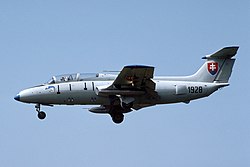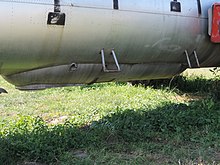Aero L-29
| Aero L-29 Delfín | |
|---|---|
 Slovak L-29 |
|
| Type: | Trainer aircraft |
| Design country: | |
| Manufacturer: |
Aero Vodochody as |
| First flight: |
April 5th 1959 |
| Commissioning: |
1963 |
| Production time: |
1963 to 1974 |
| Number of pieces: |
approx. 3600 |
The Czechoslovak Aero L-29 Delfín ( NATO code name Maya ) was the standard jet trainer of the Warsaw Treaty states in the 1960s .
history
The project planning work was carried out by Karel Tomaš and Zdeněk Rublič and began in 1955. The first flight of the prototype XL-29 (registration number: OK-70) took place on April 5, 1959 and was carried out by Rudolf Duchon.
In September 1961 a comparison flight between the L-29, the Soviet Jak-30 and the Polish TS-11 Iskra took place in Monino . With the exception of Poland , which wanted to stick to its model, all Warsaw Pact states opted for the L-29. Series production began in February 1962 with the pilot series (WNr. 190001–190010) at Aero in Vodochody and ended in 1974 after 3,665 units were built; 1722 of these were manufactured at LET in Kunovice .
The L-29 was easy to fly and undemanding to maintain, which made it a popular aircraft. In addition to the normal trainer version, there was a single-seater aerobatic version ( L-29A Delfin Akrobat ) and a pure combat and reconnaissance version L-29R with camera equipment in the bow and underwing outstations for rocket armament.
In the second half of the 1970s, the L-29 was replaced by the successor model L-39 Albatros .
construction
The L-29 was a cantilever mid -wing aircraft in all-metal half-shell construction with a circular fuselage cross-section and a T-tail unit . There were two hydraulically operated air brakes at the stern . The trapezoidal wings were not swept and each had a main spar. Two additional tanks could be carried at external load stations, which increased the range of the machine by 254 kilometers. The internal tank volume was 1330 l. The single-tire nose wheel landing gear was sprung and fully retractable.
Use and whereabouts
The L-29 was used in combat in 1967 in the Nigerian civil war . In December 1998, as part of Operation Desert Fox, a hangar in Iraq was attacked and destroyed, in which L-29s were to be converted into drones .
In Germany, L-29 machines can be found in the Finowfurt Aviation Museum (formerly 340, see photo), in the Cottbus Airfield Museum (formerly 370, WNr. 591535, in use 1965–1980), in the Military History Museum of the Bundeswehr in Dresden (formerly. 313, WNr. 692054, in use 1966–1980) and at the Chemnitz-Jahnsdorf airfield (formerly 324, WNr. 5914100). In the Air Force Museum of the Bundeswehr Berlin-Gatow is the only L-29 of the NVA that flew with a camouflage paint (formerly 338, WNr. 591525, in use 1965–1980).
The pattern is now also flown at the National Championship Air Races in Reno (Nevada) within the jet class in races against Aero L-39 , Fouga Magister and Lockheed T-33 jet trainer.
Military users
-
 Egypt
Egypt
-
 Afghanistan
Afghanistan
-
 Armenia
Armenia
-
 Azerbaijan
Azerbaijan
-
 Bulgaria : 102 from 1963 to 2002
Bulgaria : 102 from 1963 to 2002 -
 German Democratic Republic
German Democratic Republic
- Air Force / Air Defense : 51 from 1963 to 1980 with FAG-15 and FAG-25
-
 Georgia
Georgia
-
 Ghana
Ghana
-
 Guinea
Guinea
-
 Indonesia
Indonesia
-
 Iraq
Iraq
-
 Mali : 6
Mali : 6 -
 Nigeria : 26 delivered in two lots in 1967–71 and 1979–81, of which eleven were delivered to Ghana in 1989
Nigeria : 26 delivered in two lots in 1967–71 and 1979–81, of which eleven were delivered to Ghana in 1989 -
 Romania
Romania
-
 Slovakia
Slovakia
-
 Soviet Union : 2000+
Soviet Union : 2000+
-
 Syria
Syria
-
 Tajikistan
Tajikistan
-
 Czech Republic
Czech Republic
-
 Czechoslovakia : about 400
Czechoslovakia : about 400 -
 Uganda
Uganda
-
 Hungary
Hungary
-
 United States
United States
Technical specifications
| Parameter | L-29 | L-29A acrobat |
|---|---|---|
| Conception | two-seat jet trainer | single-seat aerobatic plane |
| crew | 2 (flight instructor, student) | 1 |
| Wingspan | 10.29 m | |
| length | 10.81 m | |
| height | 3.13 m | |
| Wing area | 19.80 m² | |
| Wing extension | 5.36 | k. A. |
| Wing loading | 166-179 kg / m² | k. A. |
| Power load | 3.81-4.12 kg / hp | k. A. |
| Empty mass | 2280 kg | k. A. |
| Takeoff mass | normal 3280 kg maximum 3540 kg |
normal 2600 kg |
| Engines | a jet turbine Motorlet M-701 | a jet turbine Motorlet M-701-C |
| power | 800 kp static thrust 890 kp maximum thrust |
890 kp maximum thrust |
| Top speed | 615 km / h near the ground 655 km / h at 5000 m altitude |
635 km / h near the ground |
| Marching speed | 575 km / h near the ground | k. A. |
| Rate of climb | 14 m / s | 17.3 m / s |
| Service ceiling | 11,000 m | 11,735 m |
| Take-off / landing runway | 500 m / 390 m | k. A. |
| Range | normal 640 km maximum 900 km (with additional tanks) |
k. A. |
| Gun load | maximum 200 kg | no |
Armament
Gun loading of 200 kg at two external load stations
Unguided air-to-surface missiles
- 2 × ORO-57 missile launch containers (with four unguided air-to-surface missiles of the type S-5 in caliber 57 mm)
Free falling bombs
- 2 × FAB-100 (100 kg free fall bomb )
External container
- 2 × additional tanks for 150 liters of kerosene
See also
Web links
Individual evidence
- ↑ Airventure page about Reno
- ^ Detlef Billig, Manfred Meyer: Airplanes of the GDR - Volume II until 1972. TOM Modellbau, Friedland 2002. ISBN 3-613-02241-9 . P. 78/79
- ↑ Tom Cooper: Jet fighter over Nigeria. In: Flieger Revue Extra No. 5/2004, p. 106
- ↑ http://www.strategypage.com/htmw/htnavai/articles/20100629.aspx
- ^ Karl-Heinz Eyermann : Beam trainer. Military Publishing House, Berlin 1971, p. 56.





